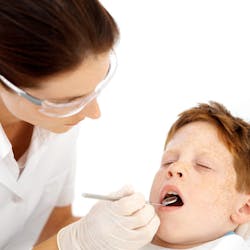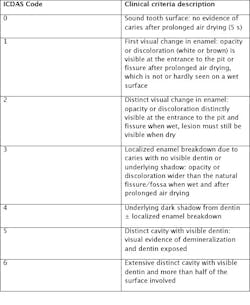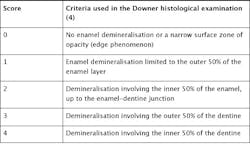In vitro evaluation of magnification and LED illumination for detection of occlusal caries
Early detection of occlusal decay in children is challenging as a diagnosis, because of the morphology of pit and fissures. One study’s goal was to investigate the use of low-powered magnification (×2.5) and its association with a light-emitting diode (LED) headlight illumination for occlusal cavity detection in primary and permanent molars using the International Caries Detection and Assessment System (ICDAS) criteria.(1,2,3) The ICDAS is an evidence-based system that standardizes data collection thus enabling proper comparison between studies.
The methods used were as follows: The occlusal surfaces of 36 extracted teeth (n=18 primary molars, n=18 permanent molars) were examined using ICDAS criteria with unaided visual examination, low-powered magnification and low-powered magnification plus LED headlight illumination. Three examiners evaluated one occlusal site per tooth twice independently with one week interval, using all methods. The teeth (n = 36) were sectioned and examined under light microscopy using Downer’s histological criteria as the gold standard.(4)
The results showed the correlation with histology and overall area under the curve (AUC) performance (0.96–0.98) of low-powered magnification plus LED headlight illumination was statistically significant in permanent molars. In primary molars, both low-powered magnification (0.82–0.90) and low-powered magnification plus LED headlight illumination (0.87–0.93) showed statistically significant correlation with histology and good to excellent AUC performance than unaided examination. The conclusion is that visual aids have the potential to improve the performance of early decay detection and clinical diagnostics in children.International Caries Detection and Assessment System (ICDAS) Criteria (1)
For more on Prevention of Dental Caries in Children From Birth Through Five Years Old, view the U.S. Preventive Services Task Force draft recommendation statement on preventing the dental caries process and resultant tooth decay in children from birth through age five.(5,6) Also, view the Guideline on Caries-risk Assessment and Management for Infants, Children, and Adolescents.(7)
References 1. Ari T, Ari N. The Performance of ICDAS-II Using Low-Powered Magnification with Light-Emitting Diode Headlight and Alternating Current Impedance Spectroscopy Device for Detection of Occlusal Caries on Primary Molars. ISRN Dent. 2013 Jul 14; 2013:276070. 2. https://www.icdas.org/uploads/ICDAS%20Criteria%20Manual%20Revised%202009_2.pdf. 3. Ismail, A.I.; Tellez, M.; Amaya, A.; Sen, A.; Hasson, H. The International Caries Detection and Assessment System (ICDAS): an integrated system for measuring dental caries. Community Dent. Oral. Epidemiol. 2007, 35, 170–178. 4. Jablonski-Momeni, A.; Heinzel-Gutenbrunner, M.; Stoll. R.; Stachniss, V. Impact of Scoring Single or Multiple Occlusal Lesions on Estimates of Diagnostic Accuracy of the Visual ICDASICDAS System. Int. J. Dent. 2009, doi:10.1155/2009/798283. 5. http://www.uspreventiveservicestaskforce.org/uspstf12/dentalprek/dnchfact.pdf. 6. http://www.uspreventiveservicestaskforce.org/draftrec.htm. 7. http://www.aapd.org/media/Policies_Guidelines/G_CariesRiskAssessment.pdf.




